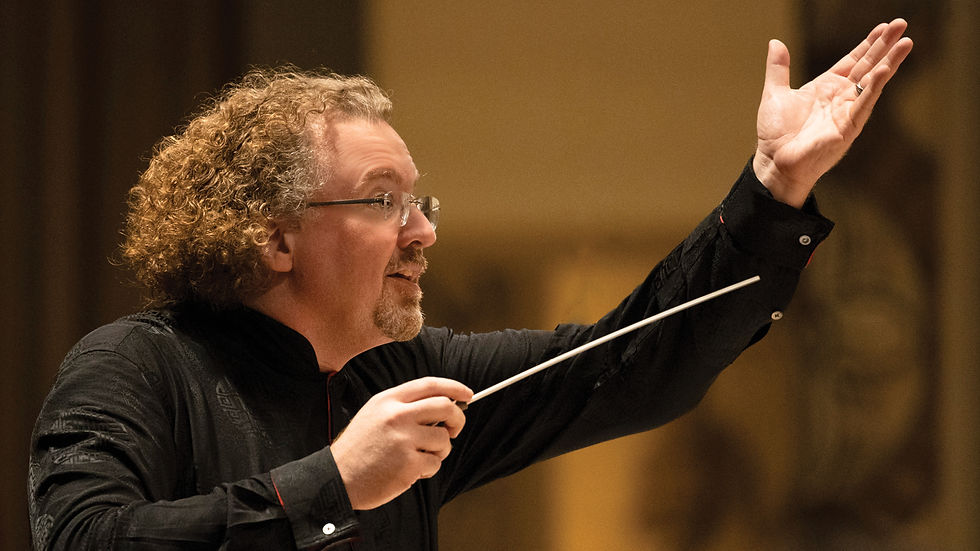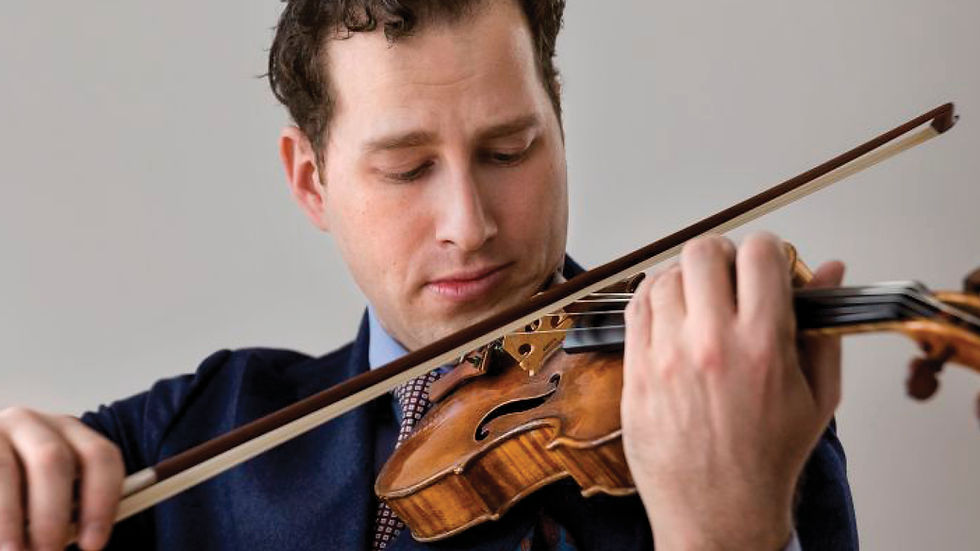Program Notes: Songs, Prayers, and Rituals (March 26-28, 2021)
- SLSO
- Mar 19, 2021
- 5 min read
Updated: Apr 19, 2021
Program
Stéphane Denève, conductor
Kristin Ahlstrom, violin
Stephanie Childress, violin
J.S. Bach
Concerto for Two Violins in D minor, BWV 1043 (~1730)
Vivace
Largo, ma non tanto
Allegro
Kristin Ahlstrom, violin
Stephanie Childress, violin
Ester Mägi
Vesper (1990/rev. 1998)
Arvo Pärt
Cantus in memoriam Benjamin Britten (1977)
Dmitri Shostakovich
Chamber Symphony in C minor, op. 110 (1960)
Largo— Allegro molto— Allegretto— Largo— Largo
Program Notes
By Tim Munro
Stéphane’s introduction
Our Spring season opens with music to cleanse your spirit: J.S. Bach. The pure beauty of the Double Violin Concerto gives a feeling of resilience and eternity. It is the sound of two souls connecting.
At this first concert we introduce a new member of the family: Stephanie Childress, our new Assistant Conductor. Stephanie joins Kristin Ahlstrom, Associate Principal Second Violinst, our two soloists in the Bach Double.
Two Estonian pieces come at the center of this program. Arvo Pärt’s Cantus is purely, perfectly organized. It has a mathematical beauty that is like the repeating patterns of a leaf.
At this time, we need to have space to think, to meditate on loss, on life. Pärt’s music explores our relationship with silence. Life starts and ends with nothingness. Music is the same: from silence to silence.
In Estonia, there’s a strong tradition of choral music. Ester Mägi’s Vesper, for string orchestra, sounds like voices singing. I miss our Symphony Chorus, and our performance of Vesper highlights the missing voices in our hall.
Finally, Dmitri Shostakovich was in a dark place when he wrote his Eighth String Quartet [performed here in an arrangement for string orchestra]. He was mourning his first wife, separated from his second, witnessing the horrible destruction of the war.
People wonder why we play sad music. As humans we have the power for compassion—music can be like a river of tears that carries painful feelings away.

Concerto for Two Violins in D minor, BWV 1043
Johann Sebastian Bach
Born March 31, 1685, Eisenach, Germany
Died July 28, 1750, Leipzig, Germany
Stepping off the street, we are greeted by the sounds and smells of a bustling coffee shop. A side door opens onto a large room, where a hushed crowd listens as two violins float above an ensemble of strings. His back to us, a stocky man leads from the harpsichord.
The coffee shop is Zimmermann’s. The music is Johann Sebastian Bach’s new Concerto for Two Violins. The man at the harpsichord is Bach himself.
Bach had recently taken the reins of this 30-year-old concert series, Leipzig’s trendiest. The busy gig must have strained his already bursting calendar. But it allowed Bach to keep up with music trends across Europe, to refine and create and show off his own instrumental music, like this concerto.
Two violins weave around each other like birds in flight: imitating, congregating, shadowing, huddling. Bach finds a perfect balance of head and heart: if the first movement feels a little stern, the second movement unwinds a floating love duet, and the third tests reaction times as the violins chase each others’ tails.
First performance: Around 1730, most likely in Leipzig with the composer performing
First SLSO performance: December 6, 1925, Rudolph Ganz conducting, with Esmeralda Berry-Mayes and Ethel Knobeloch as soloists
Most recent SLSO performance: June 20, 2010, David Halen as conductor and soloist, with Erin Schrieber as soloist
Scoring: Two solo violins, string orchestra
Approximate performance time: 17 minutes

Vesper
Ester Mägi
Born January 10, 1922, Tallinn, Estonia
At Ester Mägi’s core is a deep sincerity. She rarely writes for commission, and a single work may take her years to complete. “I keep the piece with myself and listen again and again,” she has said.
Mägi and Arvo Pärt are from Estonia. Although tiny—just one quarter of the size of Missouri—the country has a vibrant choral tradition, producing some of the world’s most accomplished choirs and choral composers.
Indeed, Mägi is best known for her choral and vocal works. Forced for decades by Estonia’s Soviet rulers to avoid religious themes, she developed a language based around her country’s folk music and poetry.
The kernel of Vesper formed during an evening church service in Estonia’s capital city, Tallinn. Mägi imagined a string choir capturing the glow of the setting sun and the singing of the church choir. The music of Vesper feels very old, like an ancient hymn passed down through generations, only now written down.
First performance, violin and piano version: December 26, 1990, by Mati Kärmas (violin) and Lilian Semper (piano), at the Estonian History Museum in Tallin
First SLSO performance: These concerts
Scoring: String orchestra
Approximate performance time: 7 minutes

Cantus in memoriam Benjamin Britten
Arvo Pärt
Born September 11, 1935, Paide, Järva County, Estonia
Arvo Pärt shuts out modern life. The ancient Russian Orthodox church has guided Pärt for 50 years: the rich sound of bells, the winding lines of chant, the hushed intimacy of a mystical connection with god.
When the English composer Benjamin Britten died, Pärt nursed a sense of loss. The two had never met, but Pärt found what he called an “unusual purity” in Britten’s music.
A bell tolls. Strings lament from on high, falling further and further each time. Violins first, but soon violas, cellos, and basses. Each part moves at a different pace. The music grows deeper, full of force. The bell continues to toll, quiet, unchanging.
Cantus in memoriam Benjamin Britten (“Song in memory of Benjamin Britten”) is about much more than the death of one person. Here is loss in musical form: how we cling to each moment, only to lose it like sand through our hands; how we try to hold memories, only to watch them fade.
“Time and timelessness are connected,” Pärt has written. “This instant and eternity are struggling within us. And this is the cause of all of our contradictions, our obstinacy, our narrow-mindedness, our faith and our grief.”
First performance: April 7, 1977, in Tallinn, Estonia, by the Estonian National Symphony Orchestra, Eri Klas conducting
First SLSO performance: By the SLSO, these concerts. By the Youth Orchestra, November 24, 2013, Steven Jarvi conducting
Scoring: String orchestra and chimes
Approximate performance time: 6 minutes

Chamber Symphony in C minor, op. 110a
Dmitri Shostakovich
Born September 25, 1906, Saint Petersburg, Russia
Died August 9, 1975, Moscow, Russia
Dmitri Shostakovich’s symphonies were public statements: many on Soviet-approved themes, many used as propaganda tools. His string quartets were different: without titles or stories, they held private thoughts.
The most personal is the Eighth String Quartet, Shostakovich’s requiem for himself. The Chamber Symphony is a faithful arrangement of the quartet made by a friend, the conductor and violist Rudolf Barshai.
“The dedication could be printed on the cover,” Shostakovich wrote in a letter. “‘Dedicated to the memory of the composer of this quartet.’” Shostakovich’s musical life—opera, symphonies, chamber works—flashes before us. His name is a constant, coded presence: the letters of his name are transformed into a short melody, ominous as a heavy rain cloud.
A vast canvas is painted in twenty minutes: desolate landscape to savage battle to bitter waltz to fragile song. At the end, the opening music reappears, hushed. Memories from the past transformed by all that has come.
First performance of the quartet: October 2, 1960, by the Beethoven Quartet, in Leningrad
First SLSO performance: These concerts
Scoring: String orchestra
Approximate performance time: 22 minutes
Tim Munro is the St. Louis Symphony Orchestra’s Creative Partner. A writer, broadcaster, and Grammy-winning flutist, he lives in Chicago with his wife, son, and badly-behaved orange cat.
Program Notes are sponsored by Washington University Physicians.




Comments